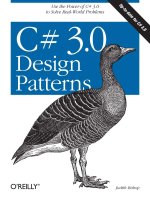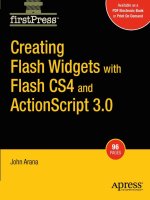Linq and C# 3.0 docx
Bạn đang xem bản rút gọn của tài liệu. Xem và tải ngay bản đầy đủ của tài liệu tại đây (263.77 KB, 58 trang )
28 JUNI 2006 |
©
CLASS
-A
A new way and language to query data
2
28 JUNI 2006 |
©
CLASS
-A
Overview
• What is Linq?
• Flavors of Linq
•
Linq to XML
•
Linq to DataSets
•
Linq to SQL
• Linq under the covers
• Linq deferred
• Q&A and/or Discussion
3
28 JUNI 2006 |
©
CLASS
-A
Introducing…
• Alex Thissen
•
Trainer/coach
•
Weblog
at
• INETA
•
Next step in user group evolution
• By and for user group community
• Class-A
•
Knowledge provider
• Training and coaching on Microsoft development
•
www.class
-
a.nl
4
28 JUNI 2006 |
©
CLASS
-A
What is Linq?
• Linq stands for Language Integrated Query
• New set of keywords in C# 3.0 and VB.NET 9.0
to express queries over data
IEnumerable
<Match>
homeMatchesWon
=
from
m
in
matches
where
m.GoalsHome
>
m.GoalsAway
order by
m.HomeTeam
,
m.AwayTeam
descending
select
m;
Dim
homeMatchesWon
As
IEnumerable(Of Match) =
From
m
In
matches
Where
m.GoalsHome
>
m.GoalsAway
Order By
m.HomeTeam
,
m.AwayTeam
Descending
Select
m
5
28 JUNI 2006 |
©
CLASS
-A
Linq
Linq project
Languages
Linq to
DataSets
Standard Query Operators
C# 3.0
VB 9.0 Other
Linq to
Entities
Linq to
XML
Linq to
Objects
Linq to
SQL
6
28 JUNI 2006 |
©
CLASS
-A
Query expressions
• Queries expressed with language keywords
• Special syntax
• Query expressions are translated into
invocations of methods
from
id in
source
[
join
id
in
source
on
expr
equals
expr
]
[
let
id =
expr
]
[
where
e
xpr
]
[
orderby
ordering, ordering,
… ]
select
expr
|
group
expr by key
[
into
id
]
7
28 JUNI 2006 |
©
CLASS
-A
Standard Query Operators
• Known set of methods to express queries
• Larger set than is integrated in language
• An other programming model for queries
•
Also called explicit dot notation
• Standard Query Operators are provided by
extension methods
• on any object that implements
IEnumerable
<T>
8
28 JUNI 2006 |
©
CLASS
-A
Explicit dot notation example
IEnumerable
<Team>
winningHomeTeams
=
matches
.
Where(m
=>
m.GoalsHome
>
m.GoalsAway
)
.
OrderBy(m
=>
m.HomeTeam.Name
)
.
Select(m
=>
m.HomeTeam
);
9
28 JUNI 2006 |
©
CLASS
-A
Standard Query Operators
GroupBy
GroupBy
Grouping
Grouping
Any, All
Any, All
Quantifiers
Quantifiers
ToArray
ToArray
,
,
ToList
ToList
,
,
ToDictionary
ToDictionary
Conversion
Conversion
Count, Sum, Min, Max, Average
Count, Sum, Min, Max, Average
Aggregation
Aggregation
First,
First,
FirstOrDefault
FirstOrDefault
,
,
ElementAt
ElementAt
Elements
Elements
Cast,
Cast,
OfType
OfType
Casting
Casting
Distinct, Union, Intersect, Except
Distinct, Union, Intersect, Except
Sets
Sets
Take, Skip,
Take, Skip,
TakeWhile
TakeWhile
,
,
SkipWhile
SkipWhile
Partitioning
Partitioning
OrderBy
OrderBy
,
,
ThenBy
ThenBy
Ordering
Ordering
Select,
Select,
SelectMany
SelectMany
Projection
Projection
Where
Where
Restriction
Restriction
10
28 JUNI 2006 |
©
CLASS
-A
Demo: Linq fundamentals
• Linq queries
• Standard query operators
• Explicit dot notation
28 JUNI 2006 |
©
CLASS
-A
Queries with hierarchical data
12
28 JUNI 2006 |
©
CLASS
-A
Linq to XML
• Power of Linq brought to data in XML format
1. Perform queries over XML data
2. New API to manipulate XML
• Alternative to XML DOM API
3. Create XML data with query expressions
13
28 JUNI 2006 |
©
CLASS
-A
New API for XML
• Builds on existing knowledge of DOM
• Element centric instead of document centric
• Functional construction of XML
• New classes represent various parts of XML
•
For example:
XElement
,
XAttribute
,
XDocument
,
XText
• Base class for all node types:
XNode
14
28 JUNI 2006 |
©
CLASS
-A
Extra Linq to XML query operators
• Defined as extension methods on
IEnumerable
<
XElement
> in
XElementSequence
• Operators for XPath axis:
•
Ancestors,
SelfAndAncestors
,
Descendants, SelfAndDescendants
,
ElementsBefore/AfterThis
,
NodesBefore/AfterThis
• Operators for node sets:
• Nodes, Elements, Attributes
•
XPath
axis sets:
Nodes,
DescendantNodes
,
AncestorNodes
,
SelfAndDescendantNodes
15
28 JUNI 2006 |
©
CLASS
-A
More Linq to XML
• Add annotations to the
XContainer
nodes
(
XElement
and
XDocument
)
• Do not show up in XML output
•
XStreamingElement
defers generation of XML
element content
•
Use in place of
XElement
•
Save
method triggers creation
• Lazy/streaming output of XML to file or writer
16
28 JUNI 2006 |
©
CLASS
-A
Demo: Linq to XML
• Querying hierarchical data
• Creating XML
• Using Linq to XML API
28 JUNI 2006 |
©
CLASS
-A
The missing functions of ADO.NET
18
28 JUNI 2006 |
©
CLASS
-A
Linq over DataSets
• Enables querying over ADO.NET
DataTable
• System.Data.DataTableis central class
• Adds some helpful extension methods to easily
load data into a
DataTable
•
LoadSequence
:
Loads data into
DataTable
•
ToDataTable
:
Convert any
IEnumerable
<T>
into a newly
created
DataTable
19
28 JUNI 2006 |
©
CLASS
-A
Extra Linq to DataSetsquery operators
•
DataTable
•
Work with sets of
DataRows
•
DistinctRows
,
EqualAllRows
,
ExceptRows
,
IntersectRows
,
UnionRows
•
DataRow
•
Adds strong typing and null support
•
Field<T>
reads from fields
•
SetField
<T>
sets values on fields
28 JUNI 2006 |
©
CLASS
-A
Queries and object/relational mapping
21
28 JUNI 2006 |
©
CLASS
-A
Linq to SQL for relational data
• Language integrated data access
• Mapping of CLR types to database tables
• Object/Relation mapping technology
•
Translates
Linq
queries to SQL statements
• Builds on ADO.NET and .NET Transactions
• Persistence services
• Automatic change tracking of objects
• Updates through SQL statements or stored
procedures
22
28 JUNI 2006 |
©
CLASS
-A
Mapping strategy
• Relationships map to collection properties
• 1 to 1 correspondence between type and table
• Single table inheritance is supported
Blog
table
Title
Name
ID
Data context
Posting table
Posted
Body
ID
Blog object
Posting objects
23
28 JUNI 2006 |
©
CLASS
-A
Mapping from objects to relations
• Two mapping mechanisms between CLR and
database world
1.
Attributes on CLR types
2.
XML mapping file
• Table<T> class handles mapping and
materialization of objects into context
• SqlMetal.exetool and DLinq designer help in
generation of both mapping types
24
28 JUNI 2006 |
©
CLASS
-A
Attribute-based mappings
[
System.Data.DLinq.
Table(Name
="
Blogs
")
]
public partial class
Blog
{
private string _Name;
[
System.Data.DLinq.
Column(Name
="Name",
Storage="_Name",
DBType
="
nvarchar
NOT NULL")
]
public virtual string Name {
get { return
this._Name
; }
set {
if ((
this._Name
!= value)) {
this.OnPropertyChanging("Name
");
this._Name
= value;
this.OnPropertyChanged("Name
");
}
}
}
}
25
28 JUNI 2006 |
©
CLASS
-A
Contexts of data objects
• Objects returned from Linq to SQL queries are
materialized into DataContext
• DataContext class handles
•
Change tracking
•
Object identity
• Currently load context of objects can be saved,
discarded or accepted
• EntitySet<T> uses lazy loading of related
collections into context









